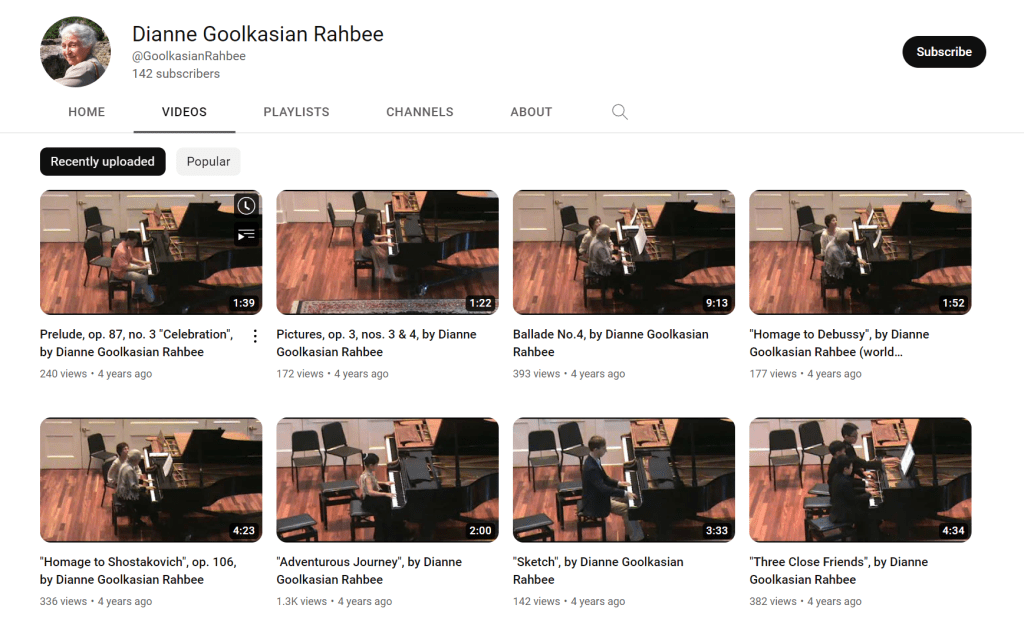Don’t miss Leonidas Lagrimas’ Inspiring Artistry contribution about Amy Beach’s Improvisation Op. 148, No. 1, which includes exposition on how to effectively teach the piece, all the way from preparation to performance.

The piano music of Dianne Goolkasian Rahbee has been steadily gaining popularity over the past several decades, to the point where her work is regularly featured on recital programs, festival lists, at new music conferences, and even on the Royal Conservatory’s Celebration Series. A major reason for her music’s popularity is its seamless combination of sound pedagogical writing, innovative compositional techniques, and her unique yet accessible harmonic language. Plus, much of her music is just plain fun for students and concert artists alike to play! Read on for more about this fascinating female composer and her music.
1. She is of Armenian descent.
Dianne Goolkasian Rahbee is a first-generation Armenian American, and her father was a survivor of the Armenian genocide of 1915. Much of her work reflects her own multiculturally ethnic background and upbringing, as well as the folk music of her Armenian heritage. Teachers looking to explore a composer who utilizes folk rhythms, melodies, and harmonies in the style of Bartok should investigate Goolkasian Rahbee’s compositions.



2. She began composing in her 40s.
Goolkasian Rahbee was a Juilliard-trained pianist whose pedagogical lineage traces back through Leschetizky and Paderewski. Proving that it’s never too late (or too soon!) to explore new interests and follow your dreams, Goolkasian Rahbee took up composition in her 40s and was largely self-taught. She started out composing pieces for her own private piano students before finding success in piano pedagogical publications.
3. Her Preludes feature aleatoric, or chance, music elements for young students.
Teachers seeking opportunities for their youngest performers to explore creativity and chance music on the piano would do well to explore Goolkasian Rahbee’s Preludes. In particular, her Prelude, Op. 138 (“Escape to Innerspace”) is written in a free meter, allowing students to explore a fixed set of pitches and apply whatever rhythms, meters, and phrasings they wish. Students are also free to make decisions involving repeats, fermatas, and pedaling.

4. Goolkasian Rahbee often “samples” familiar tunes in her original works.
Goolkasian Rahbee’s “Tinkle Winkle” from her Modern Miniatures, Vol. 1 is a bitonal take on the familiar “Twinkle Twinkle Little Star” melody. Her arrangement on “Mary Had a Little Lamb” from the same collection gives the familiar nursery rhyme a canonic treatment. Her sampling isn’t limited to children’s music either! The hauntingly familiar melody from Chopin’s Prelude in E Minor Op. 28 inspired her Prelude, Op. 5 no. 1.
5. She maintains a prolific YouTube presence.
If you are interested in discovering some of Goolkasian Rahbee’s vast output for piano, check out her YouTube channel at https://www.youtube.com/@GoolkasianRahbee/videos. This channel features hundreds of student, amateur, and professional recital performances of her piano works, from beginner through concert artist level.

Other resources you might enjoy
- POST: 5 Things You Might Not Know About Lita Spena, by Florencia Zuloaga
- POST: 5 Things You Might Not Know About Practicing the Piano, by Sheryl Iott
- POST: 5 Things You Might Not Know About Zoltán Kodály, by Megan Rich
- WEBINAR ARCHIVE: Piano Inspires…. Innovation in Teacher Education, featuring Leonidas Lagrimas and colleagues
NOT YET A SUBSCRIBER? JOIN FOR ONLY $7.99/MO OR $36/YR.
Sources
- Cash, M. (2013). The solo piano works of Dianne Goolkasian Rahbee. [Doctoral dissertation, University of Houston]. Accessed at: uh-ir.tdl.org/handle/10657/2621
- Dianne Goolkasian Rahbee (Composer Webpage). Accessed at: dgoolkasianrahbee.com/index.html
- Dianne Goolkasian Rahbee-Composer Page at FJH Music. Accessed at: fjhmusic.com/piano/authors.php?id=199
- Papinsick, A. (2020). “The post-tonal pedagogical piano music of Dianne Goolkasian Rahbee.” The University of New Hampshire Inquiry Journal. Accessed at: unh.edu/inquiryjournal/spring-2020/post-tonal-pedagogical-piano-music-dianne-goolkasian-rahbee.
- Rahbee, D. (2007). Preludes, Vol. 1. Fort Lauderdale, FL: FJH Music Company Inc.
